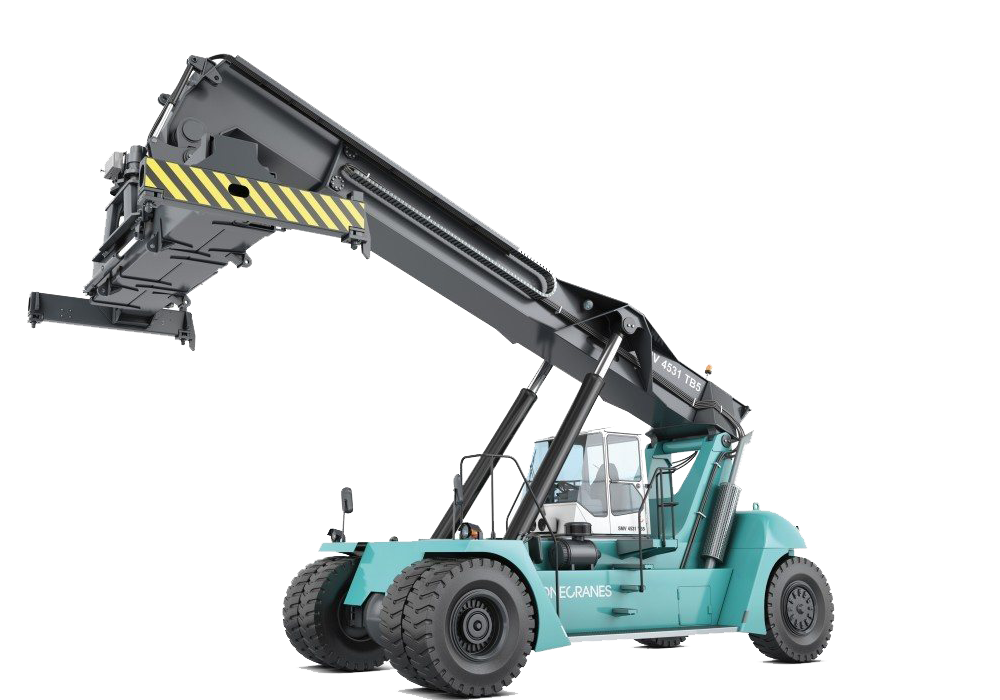
Foreword
This manual’s purpose is to remind users of potential dangers associated with using equipment without proper instruction, knowledge, and safety practices. No single rule in the booklet can be followed to the exclusion of others. Each rule must be considered in light of the other rules, the knowledge and training of the man (operator), the limitations of the machine, and the workplace environment. This manual, of course, cannot cover all circumstances and situations. We urge all users of equipment to obtain necessary training and instruction;
make sure the equipment has been serviced and systems are functioning properly before operation; make sure the environment is proper for the operation of the machine, and always be alert and cautious.
Introduction
Powered industrial trucks with a variable reach pivoting boom, commonly called reach stackers, come in many shapes and sizes, and are intended for use in general industry. They lift, carry, and deposit many different types, sizes, and weights of loads. They are under the control of an operator who works in an environment controlled by the employer. The reach stacker can be a safe tool, but only if the operator himself is safe and works in an environment made safe by the employer. Safe operation does not just happen. It is the result of hard work and planning. Knowing the types of accidents that commonly occur with reach stackers can help both the operator and the employer plan ahead. The most common types of accidents are :
A. Stability Related Accidents
1. Forward tip over
2. Lateral tip over
B. Operations Related Accidents
C. Pedestrian Related Accidents
1. Forward
2. Reverse
3. Tailswing
D. Slip and Fall Accidents
E. Maintenance / Servicing Accidents
Safe operation requires a systematic check of
the Man
the Machine
and the Environment.
The following checklists can be used as guides to fulfill your responsibility for reach stacker safety.
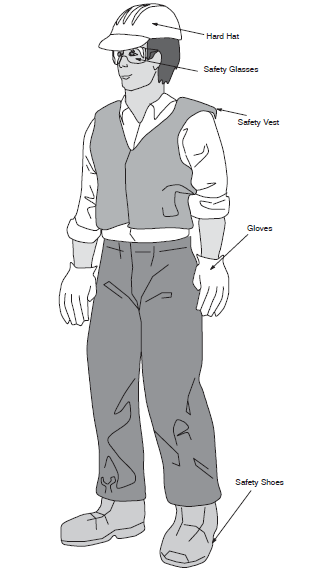
Man Check
The Operator should fully understand :
- OSHA operating rules found in 29 CFR 1910.178; Appendix A in this booklet
- ANSI B56.1 rules for operating a powered industrial truck; Appendix B in this booklet
- The Operator’s Guide for the reach stacker
- Manufacturer’s Safety Booklet
- Manufacturer’s Safety Video
- Manufacturer’s Service Bulletins
- Content and meaning of all machine decals
The operator should :
- Be 18 years of age or older per OSHA 29 CFR 570.58 (order 7)
- Satisfactorily complete manufacturer’s written test
- Satisfactorily demonstrate driving skills to the employer
- Satisfactorily complete independent testing (company’s written and hands-on certification course)
- Know employer’s safety rules
- Be in good health and not be suffering from any physical limitations that would inhibit safe reach stacker operation
- Not be under the influence of drugs or alcohol including prescription or over-the-counter medications
- Wear protective clothing needed for safe operation
> hard hat
> safety shoes
> safety glasses
> heavy gloves
> hearing protection
> reflective clothing
- Know where fire extinguishers are located and how to use the extinguishers
- Know where first aid accessories are located and how to summon help
- Be familiar with all reach stacker functions and safety related equipment
- Be fully knowledgeable of the environment in which the reach stacker will be operating
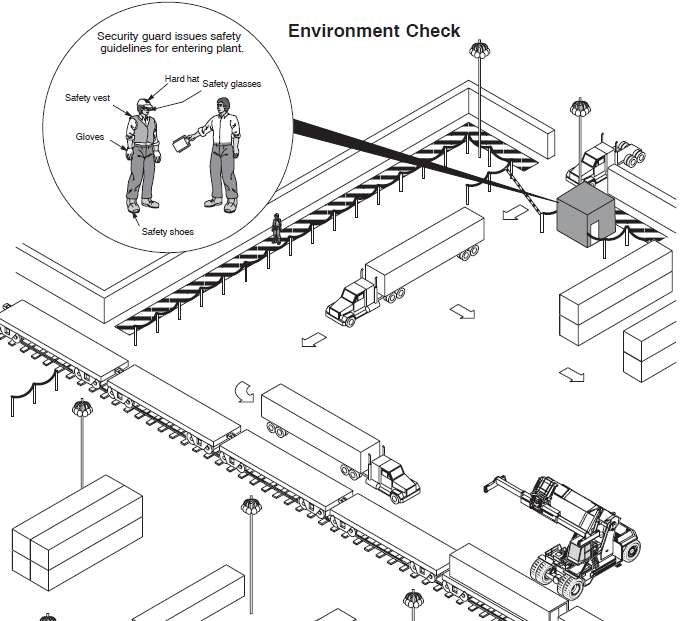
Check The Work Area Daily Before Operating The Machine. Make Sure :
- Pedestrians are restricted from reach stacker operation areas
- Pedestrian walk paths are clearly marked and guarded
- Reach stacker travel lanes are clearly marked
- Pedestrian barriers are in place
- Pedestrians are wearing high visibility vests and hats
- Transient personnel (truck drivers) have received written rules on:
- dismounting trucks
- staying clear of reach stacker operations
- Safe access is provided to restrooms and break areas
- Control measures are in place at pedestrian / machine intersections
- Aisleway mirrors at blind intersections are in place and clean
- All persons are knowledgeable of workplace dangers
- Adequate lighting is in place
- Work rules are in place and enforced
- Reach stacker operator/pedestrian communications are in place and operable
- Operating surfaces are free of potholes and debris
- Safe speed limits are established, posted, and enforced
Stability Related Accidents
Some causes of stability related accidents are :
- Operating the reach stacker without proper training.
- Operating the machine without understanding that rated capacity is dependent on boom position.
- Braking too hard or too quickly with a load; accelerating too quickly.
- Turning too sharply or too quickly; turn the steering wheel slowly.
- Raising the load when wind velocity is excessive.
- Operating the machine on uneven surfaces or in unstable yard conditions.
- Extending or lowering the boom with a load not over a stack, or railcar.
- Traveling with the load raised too high or extended too far.
- Traveling without the seat belt fastened.
- Jumping from a moving or tipping machine.
- Handling an off-center load improperly.
- Traveling on an incline with the load downhill
- Backing away from a load in a rack or stack without completely releasing the load
- Operating the machine in areas with inadequate overhead clearance
Understanding the following definitions is critical to understanding the principles of stability.
Center of Gravity
that point of an object at which all of the weight of an object can be considered to be concentrated.
Counterweight
is the weight that is a part of the basic structure of a truck that is used to offset the weight of a load and to maximize the resistance of the vehicle to tipping over.
Fulcrum
is the axis of rotation of the truck when it tips over.
Grade
is the slope of any surface that is usually measured as the number of feet of rise or fall over a hundred foot horizontal distance (this measurement is designated as a percent).
Lateral stability
is the resistance of a truck to tipping over sideways.
Line of action
is an imaginary vertical line through the center of gravity of an object.
Load center
is the horizontal distance from the front tires to the line of action through the center of gravity of the load.
Longitudinal stability
is the resistance of a truck to overturning forward or rearward.
Moment
is the product of the weight of the object times the distance from a fixed point. In the case of a reach stacker, the distance is measured from the point that the truck will tip over to the line of action of the load. The distance is always measured perpendicular to the line of action.
Track
is the distance between wheels on the same axle of a vehicle.
Wheelbase
is the distance between the centerline of the front and rear wheels of a vehicle.
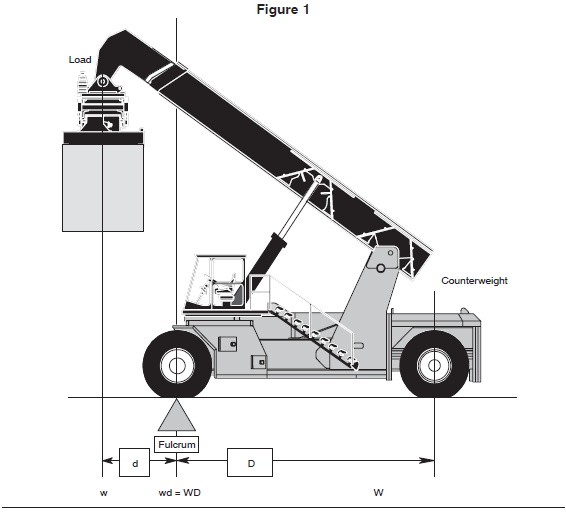
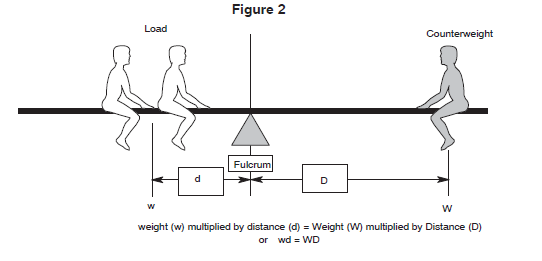
The Principles of Counterbalance
A reach stacker (like the see-saw or any counterbalanced equipment) has a balance point or fulcrum. The fulcrum for the longitudinal (forward and rearward) axis of the machine is the centerline of the front tires.
The principles of counterbalance can be explained as follows.
The weight of the portion of the reach stacker located rearward of the front tire centerline, Figure 1, represents the weight of one child located at distance “D” from the fulcrum, Figure 2.
The weight of the boom attachment, and the load itself, Figure 1, represent the weight of the children, Figure 2, located at distance “d” from the fulcrum. On the see-saw, the children move either in or out from the fulcrum, relocating their weight at distances “d” or “D” until they balance each other. The see-saw balance can be illustrated by stating that weight “w”
multiplied by distance “d” equals weight “W” multiplied by distance “D”. This illustrates that various combinations of weight “multiplied by distance” can create a balanced condition.
The principles of stability in a reach stacker are like a see-saw in that the weight of the load and its distance from the fulcrum determine counterbalance requirements. Remember that the reach stacker is different because the weight rearward of the drive axle centerline (fulcrum) multiplied by the distance to the “CG” (center of gravity) of that weight must always be greater
by a wide margin than the weight forward of the drive axle multiplied by the distance to its “CG.” If a balanced condition is approached, dynamic forces involved in stopping, traveling, or tilting can cause a dangerous vehicle upset. The weight of the reach stacker located rearward of the fulcrum and the “CG” of this weight does not change; therefore, counterbalance is always a fixed value.
The weight of the boom and attachment is also a fixed weight; but, the distance to the “CG” forward of the fulcrum is variable depending on the angle and extension of the boom.
The moment of the load changes as its location forward of the fulcrum changes. Its location is dependent upon the boom angle, and the extended length, of the boom. The operator must control these variables and ensure that the total weight forward of the fulcrum multiplied by the location of the combined center of gravity plus the other dynamic forces of operation never exceed the counterbalance of the reach stacker. Following these safety rules and using good, common-sense judgement will help ensure safe operation of the reach stacker. Reach stackers are designed to keep everything in proper balance; many different factors affect this balance :
– capacity of the machine (at a specified load center)
– weight of the load and its center of gravity
– position of the load on the attachment
– type and weight of the attachment
– acceleration or braking
– condition of the ground surface and grade angle
– lift and extension of the boom
– weather conditions
The operator must consider these factors before operating the machine. Each of these factors can affect safe operation of the machine.
The balance for proper operation is safe if all different parts of the machine are properly maintained AND the machine is safely operated by you, the operator.
For your safety you must :
– know the reach stacker’s size
– know the reach stacker’s operating capacity
– know how to operate the reach stacker
– know what safety features are available
– know the safe operating procedures at your work site
– check the reach stacker daily for proper operation
– use every safety feature
– follow safe operating procedures
 Death or serious injury may result from improper operation of this machine. Many safety features are designed into reach stackers to help protect you (the operator), your fellow
Death or serious injury may result from improper operation of this machine. Many safety features are designed into reach stackers to help protect you (the operator), your fellow
workers, and the property in the area where you work.
But . . .
NO safety feature . . NO safety equipment is effective unless you operate the machine properly – every time !
The instructions in this manual, the OSHA Standards, and ASME/ANSI B56.1 are all intended to advise how to operate this vehicle safely. These instructions are primarily directed at one or the other of the two basic modes of reach stacker operation. They are (a) the loading or stacking mode, and (b) the traveling The transitional operation between these modes must be accomplished with extreme care. Regardless of all the safety features we build into our equipment, safe operation still largely depends upon the operator’s safe, cautious observance of safety rules.
Operation and Stability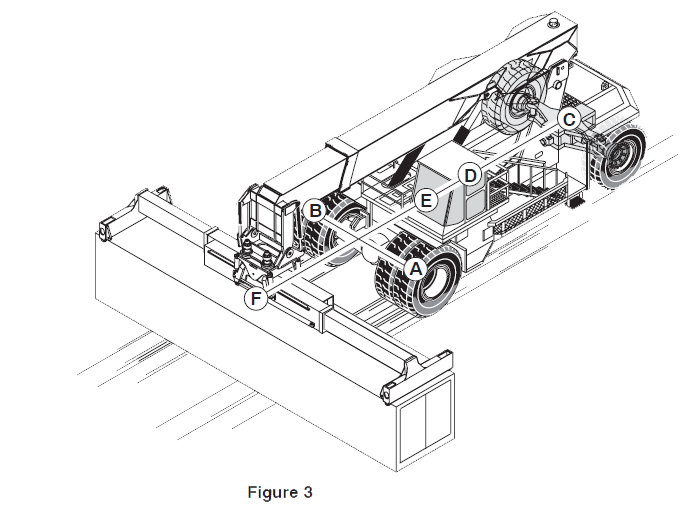
The rated capacity of a counterbalanced reach stacker applies only when the truck is on level ground and the load is at the proper height and distance from the front wheels.
It is important that you understand this capacity is reduced and the truck is less stable when :
– the boom is raised
– the boom is extended
– the truck is on an incline
Reach stacker stability is dependent on the truck’s three point suspension represented by Figure 3. The truck is upported on the drive axle tires (points A and B) and the centerline of the steer axle pivot (point C). Point D represents the location of the center of gravity of a truck without a load. Point F represents the center of gravity of the load. Point E represents the combined center of gravity of both the empty truck and the load. The combined center of gravity (point E) must remain within the triangle formed by points A, B, and C. Stability depends on how close point E comes to the edge of this triangle. If for any reason this point exceeds the triangle’s boundary, the truck will tip.
Forward Stability
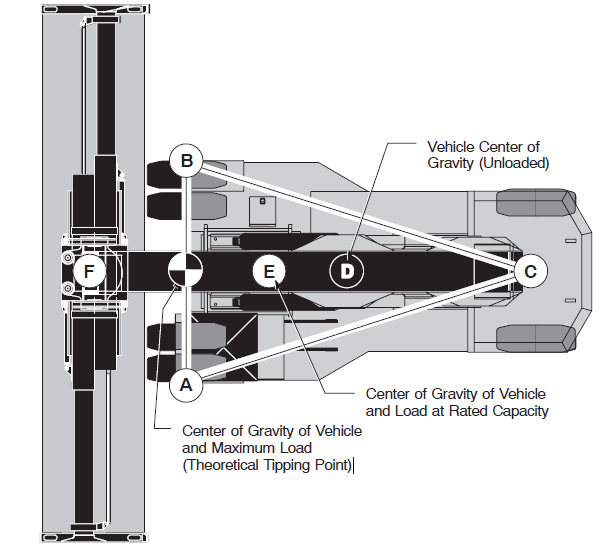
NOTES :
- When the vehicle is loaded, the combined center of gravity shifts toward line A-B. Theoretically a load that will cause forward tipover will result in the CG at or past the line A-B. Therefore, in actual practice, the combined CG should never be at line A-B. Rated loads will result in the combined CG always being well within the stability triangle.
- Simply adding additional counterweight will not solve forward stability issues, because added counterweight will cause the truck center of gravity to shift toward point C and will result in a truck that is less stable laterally.
Forward stability is directly affected by how close Point E is to the line connecting points A and B. If for any reason the combined center of gravity of both truck and load crosses line AB, he truck will tip forward.
Sumber : sanggapramana.wordpress.com
Jadwal dan Daftar Harga Pelatihan/Training.
Utk Informasi Lebih Lanjut atau ada yang mau di Tanyakan Silahkan Hubungi ke Customer Service kami, dengan Click Contact US. atau Silahkan Chat Kami dengan Live Chat KMMI yg ada di bawah Page.


